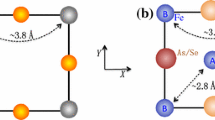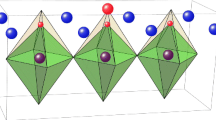Abstract
The degree of the isolation of the CuO2 planes (e.g. distance or bond valence to the apical coordination) has been shown by quantitative algorithms to be the major factor in determining aspects of the doping curves. They include the magnitude of the optimal number of doped holes (hop) and the corresponding T cop. It is shown that the roots of these phenomenological laws lie in a related structural dependence of super-exchange. The latter is expressed in the pseudo-gap or Neel temperature of the undoped parent compound. A fruitful language can be developed which deals with a buildup of complex quantum chemical features by bringing two holes into vicinity of a super-exchange O, forming a “local” Cu2O7 pair. Structural considerations also dictate that stress is relieved by alternate orthogonal pair orientation. This leads to plaid patterns with primary and secondary channels of charge. The presence of these two types of charge channels is involved in the mechanism of superconducting charge transport. Similar structuring of doped charge into plaid patterns of “local” pairs has been proposed for “all” high T c superconductivity. STM now gives pictorial representation of the remnants of such an electronic crystal structure. The response of these bond-ordering motifs to structural details is further discussed. These ideas supply organization to the manifold experimental situation and provide opportunities for a unifying theory for high T c superconductivity in terms of real space structuring of “local” pairs, largely on crystal-chemical principles.
Similar content being viewed by others
References
A. R. Bishop, Curr. Opin. Solid State Mater. Sci. 2, 244 (1997).
J. B. Goodenough and J. S. Zhou, Struct. Bond. 98, 17 (2001); J. B. Goodenough, Europhys. Lett. 57, 550 (2002).
C. Park and R. L. Snyder, J. Am. Ceram. Soc. 78, 3171 (1995).
J. E. Hoffman, E. W. Hudson, K. M. Lang, V. V. Madharan, H. Eisaki, S. Uchida, and J. C. Davis, Science 295, 466 (2002).
H. A. Mook, P. Dai, and F. Dogan, Phys. Rev. Lett. 88, 97004 (2002).
T. Hanagurii, Nature 430, 1001 (2004).
K. M. Shen, F. Ronning, D. H. Lu, F. Baumberger, N. J. C. Ingle, W. S. Lee, W. Meevasana, Y. Kohsaka, M. Azuma, M. Takano, H. Takagi, and Z.-X. Shen, Science 307, 901–904 (2005).
Y. Zhang, E. Demler, and S. Sachdov, Phys. Rev. B 66, 94501 (2002).
J. Zhu, I. Martin, and R. A. Bishop, Phys. Rev. Lett. 89, 67003 (2002).
M. Voita, Phys. Rev. B 66, 104505 (2002).
H. Oesterreicher, J. Low Temp. Phys. 177, 993 (1999).
H. Oesterreicher, J. Solid State Chem. 158, 139 (2001).
H. Oesterreicher, J. Superconductivity 16, 507 (2003).
H. Oesterreicher, J. Superconductivity 17, 439 (2004).
J. M. Tranquada, B. J. Sternlieb, J. D. Axe, Y. Nakamura, and S. Uchida, Nature 375, 561–563 (1995).
H. Kotegawa, Y. Tokunaga, K. Ishida, G.-Q. Zhang, Y. Kitaoka, H. Kito, A. Iyo, K. Tokiwa, T. Watanabe, and H. Ihara, Phys. Rev. B 64, 064515 (2001).
H. A. Mook, P. Dai, S. M. Hayden, G. Aeppli, T. G. Perring, and F. Do, Nature 395, 580–582 (1998).
B. O. Wells, Science 277, 1067 (1997).
Author information
Authors and Affiliations
Corresponding author
Rights and permissions
About this article
Cite this article
Oesterreicher, H. Superconductivity and Structure. J Supercond 20, 201–213 (2007). https://doi.org/10.1007/s10948-006-0137-z
Published:
Issue Date:
DOI: https://doi.org/10.1007/s10948-006-0137-z




